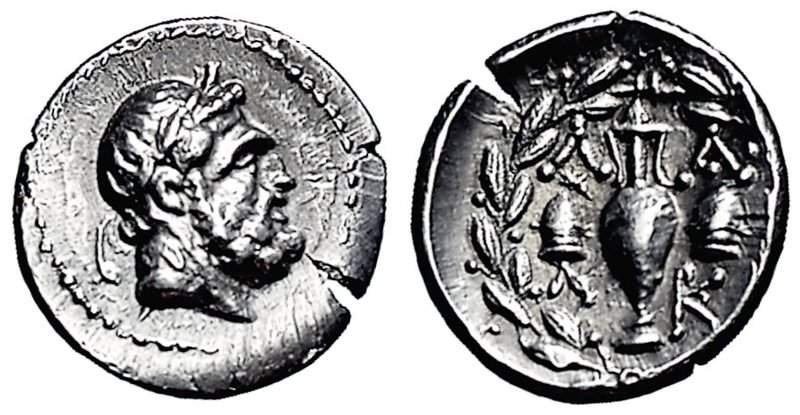H 180 - Lacedaemon, silver, hemidrachms (219-196 BCE)
From SILVER
219 BCE - 196 BCE Silver 4,575 kg
Description
| ObverseInscription or printing placed on the obverse.: | Head of Heracles right, bearded and wearing diadem (?). Border of dots. |
| ReverseInscription or printing placed on the reverse.: | ΛΑ (Greek).Amphora between the pilei of the Dioscuri. |
Mint and issuing power
| MintIdentifies the place of manufacture or issue of a numismatic object.: | Lacedaemon | Ancient regionAncient region.: | Peloponnesus (Laconia) | Modern countryModern country: Greece | AuthorityIdentifies the issuing power. The authority can be "pretended" when the name or the portrait of X is on the coin but he/she was not the issuing power. It can also be "uncertain" when there is no mention of X on the coin but he/she was the issuing power according to the historical sources: |
Chronology
| FromIdentifies the initial date in a range assigned in a numismatic context. | 219 BCE | toIdentifies the final date in a range assigned in a numismatic context.. | 196 BCE | PeriodTime period of the numismatic object.: Hellenistic 323-30 BC |
Physical description
| MetalThe physical material (usually metal) from which an object is made.: | Silver |
Median weightMedian of the weights of numismatic objects (in grams). in grams | 2.30 | DenominationTerm indicating the value of a numismatic object. Examples: tetradrachm, chalkous, denarius.: | hemidrachm |
StandardStandard.: |
Image

H180 Herakles Dioscuri.jpeg [1]
References
| Die study referencePublication of the study: | Grunauer-von Hoerschelmann 19781Grunauer-von Hoerschelmann 1978 | ||
| Coin series referenceReference to coin series study: | RQEMH2RQEMH, n° 180 | ||
Obverse dies distribution
| FrequencyFrequency of specimen in distribution. ᵖ | Number of obversesNumber of obverse dies. ᵖ (o) | % (o) | Number of coinsNumber of coins. (n) | % (n) | Die nameName(s) of the die(s). |
| 1 | 25 | 33.33 | 25 | 12.14 | 6, 7, 17, 18, 19, 21, 24, 35, 36, 37, 38, 43, 44, 48, 52, 61, 63, 64, 65, 67, 68, 70, 71, 72, 75 |
| 2 | 20 | 26.67 | 40 | 19.42 | 4, 5, 11, 13, 15, 16, 20, 22, 25, 34, 39, 47, 50, 51, 53, 56, 58, 66, 73, 76 |
| 3 | 10 | 13.33 | 30 | 14.56 | 2, 3, 14, 27, 31, 32, 45, 46, 57, 74 |
| 4 | 5 | 6.67 | 20 | 9.71 | 1, 28, 29, 33, 41 |
| 5 | 7 | 9.33 | 35 | 16.99 | 8, 9, 23, 40, 55, 60, 69 |
| 6 | 4 | 5.33 | 24 | 11.65 | 10, 42, 59, 62 |
| 7 | 1 | 1.33 | 7 | 3.4 | 26 |
| 8 | 2 | 2.67 | 16 | 7.77 | 12, 54 |
| 9 | 1 | 1.33 | 9 | 4.37 | 30 |
| Total | 75 of 75 | 99.99 | 206 of 206 | 100.01 |
Reverse dies distribution
no distribution is available
Quantification
| Number of obversesNumber of obverse dies. ᵖ (o) | 75 | Number of singletons (o1)The number of singleton coins. ᵖ | 25 |
| Number of reverse diesNumber of reverse dies. (r) | 113 | Number of coinsNumber of coins. (n) | 206 |
| Coins per obverse dieNumber of coins per obverse die. (n/o) | 2.75 | Coins per reverse dieNumber of coins per reverse die. (n/r) | 1.82 |
| Reverse per obverse ratioRatio of obverse dies divided by reverse dies. (r/o) | 1.51 | Percentage of singletons (o1)number of coins (n) divided by the number of singletons (o1) ᵖ | 33.33 % |
| Original number of dies (O) (Carter 1983 formula)The estimation of the number of coins according to Carter 1983 ᵖ | 99.46 | Coins struck if 20,000 as average productivity per dieCoins made if the average productivity for obverses (according to Carter) is 20,000. ᵖ | 1,989,200 |
| Original number of dies (O) (Esty 2011 formula)The estimation of the number of coins according to the singleton formula in Esty 2011 ᵖ (O) | 117.94 | Survival rate if 20,000 as average productivity per dieSurvival rate if average productivity is 20,000. ᵖ | 0.00010 |
| Coverage (o = % of O) (Esty 1984 formula)Esty 1984 - coverage (% of O) ᵖ (o = % of O) | 87.86% | Die productivity if survival rate 1/2,000Average productivity if survival rate is 1/2,000. ᵖ | 4,142.37 |
| Weight of silver (in kg) if 20,000 coins per die (O = Carter formula)Carter 1983 * Median weight * 20000 (*10 if gold or electrum) ᵖ | 4,575 kg <br /> 4,575 kg | Die productivity if survival rate 1/5,000Average productivity if survival rate is 1/5,000. ᵖ | 10,355.92 |
Remarks
Most likely one single workstation